Abdulmejid I
Abdulmejid I (Ottoman Turkish: عبد المجيد اول, romanized: Abdülmecîd-i evvel, Turkish: Birinci Abdülmecid; 25 April 1823 – 25 June 1861), was the 31st Sultan of the Ottoman Empire and succeeded his father Mahmud II on 2 July 1839.[4] His reign was notable for the rise of nationalist movements within the empire's territories. Abdulmejid wanted to encourage Ottomanism among secessionist subject nations and stop rising nationalist movements within the empire, but despite new laws and reforms to integrate non-Muslims and non-Turks more thoroughly into Ottoman society, his efforts failed.
| Abdulmejid I عبد المجيد اول | |||||
|---|---|---|---|---|---|
| Ottoman Caliph Amir al-Mu'minin Kayser-i Rûm Custodian of the Two Holy Mosques Khan | |||||
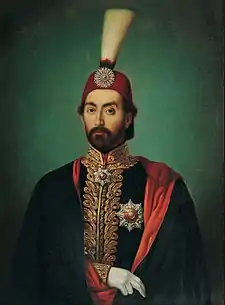 A painting of Abdulmejid at the Pera Museum in Istanbul (oil on canvas, 1850s). | |||||
| 31st Sultan of the Ottoman Empire (Padishah) | |||||
| Reign | 2 July 1839 – 25 June 1861 | ||||
| Predecessor | Mahmud II | ||||
| Successor | Abdulaziz | ||||
| Born | 25 April 1823[1][2] Constantinople, Ottoman Empire | ||||
| Died | 25 June 1861 (aged 38) Constantinople, Ottoman Empire | ||||
| Burial | Yavuz Selim Mosque, Fatih, Istanbul | ||||
| Consorts | |||||
| Issue | see below | ||||
| |||||
| Dynasty | Ottoman | ||||
| Father | Mahmud II | ||||
| Mother | Bezmiâlem Sultan | ||||
| Religion | Sunni Islam | ||||
| Tughra |  | ||||
He tried to forge alliances with the major powers of Western Europe, namely the United Kingdom and France, who fought alongside the Ottoman Empire in the Crimean War against Russia. In the following Congress of Paris on 30 March 1856, the Ottoman Empire was officially included among the European family of nations.
Abdulmejid's biggest achievement was the announcement and application of the Tanzimat (reorganization) reforms which were prepared by his father and effectively started the modernization of the Ottoman Empire in 1839. For this achievement, one of the Imperial anthems of the Ottoman Empire, the March of Abdulmejid, was named after him.
Early life
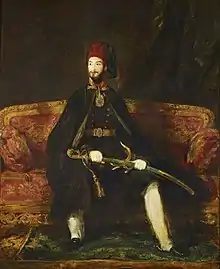
Abdulmejid was born on 25 April 1823 at the Beşiktaş Sahil Palace or at the Topkapı Palace, both in Istanbul.[5] His mother was his father's first wife in 1839, Valide Sultan Bezmiâlem, originally named Suzi (1807–1853), either a Circassian[6] or Georgian slave.[7][8][9]
Abdulmejid received a European education and spoke fluent French, the first sultan to do so.[1] Like Abdülaziz who succeeded him, he was interested in literature and classical music. Like his father Mahmud II, he was an advocate of reforms and was lucky enough to have the support of progressive viziers such as Mustafa Reşit Pasha, Mehmet Emin Ali Paşa and Fuad Pasha. Abdulmejid was also the first sultan to directly listen to the public's complaints on special reception days, which were usually held every Friday without any middlemen. Abdulmejid toured the empire's territories to see in person how the Tanzimat reforms were being applied. He travelled to İzmit, Mudanya, Bursa, Gallipoli, Çanakkale, Lemnos, Lesbos and Chios in 1844 and toured the Balkan provinces in 1846.
Reign
When Abdulmejid succeeded to the throne on 2 July 1839 when he was only sixteen, he was young and inexperienced, the affairs of the Ottoman Empire were in a critical state. At the time his father died at the start of the Egyptian–Ottoman War, the news reached Istanbul that the empire's army had just been defeated at Nizip by the army of the rebel Egyptian viceroy, Muhammad Ali. At the same time, the empire's fleet was on its way to Alexandria, where it was handed over to Muhammad Ali by its commander Ahmed Fevzi Pasha, on the pretext that the young sultan's advisers had sided with Russia. However, through the intervention of the European powers during the Oriental Crisis of 1840, Muhammad Ali was obliged to come to terms, and the Ottoman Empire was saved from further attacks while its territories in Syria, Lebanon and Palestine were restored. The terms were finalised at the Convention of London (1840).[1]
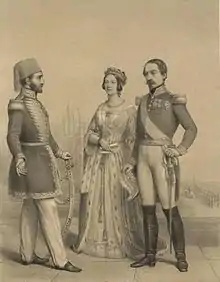
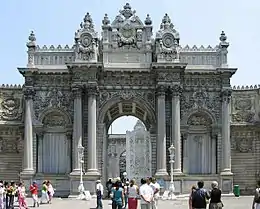
Egyptian governor Mehmed Ali Pasha, who came to Istanbul as the official invitation of the sultan on July 19, 1846, was shown privileged hospitality by the sultan and vükela. So much so that the old vizier built the Galata bridge in 1845 so that he could drive between Beșiktaș Palace and Babıali. [10]
In compliance with his father's express instructions, Abdulmejid immediately carried out the reforms to which Mahmud II had devoted himself. In November 1839 an edict known as the Hatt-ı Șerif of Gülhane, also known as Tanzimat Fermanı was proclaimed, consolidating and enforcing these reforms. The edict was supplemented at the close of the Crimean War by a similar statute issued in February 1856, named the Hatt-ı Hümayun. By these enactments it was provided that all classes of the sultan's subjects should have their lives and property protected; that taxes should be fairly imposed and justice impartially administered; and that all should have full religious liberty and equal civil rights. The scheme met with strong opposition from the Muslim governing classes and the ulema, or religious authorities, and was only partially implemented, especially in the more remote parts of the empire. More than one conspiracy was formed against the sultan's life on account of it.[11]
Among measures promoted by Abdulmejid were:
- Introduction of the first Ottoman paper banknotes (1840)
- Reorganisation of the army, including the introduction of conscription (1842–1844)[1]
- Adoption of an Ottoman national anthem and Ottoman national flag (1844)
- Reorganisation of the finance system according to the French model
- Reorganisation of the Civil and Criminal Code according to the French model[1]
- Reorganisation of the court system, establishing a system of civil and criminal courts with both European and Ottoman judges.[1]
- Establishment of the Meclis-i Maarif-i Umumiye (1845) which was the prototype of the First Ottoman Parliament (1876)
- Institution of a council of public instruction (1846)
- Creation of the Ministry of Education[1]
- According to legend,[12][13][14] plans to send humanitarian aid of £10,000[15] (£1,225,053.76 in 2019[16]) to Ireland during its Great Famine, but later agreed to reduce it to £1,000[15] (£122,505.38 in 2019[16]) at the insistence of either his own ministers or British diplomats to avoid violating protocol by giving more than Queen Victoria, who had made a donation of £2,000.[15]
- Plans to abolish slave markets (1847)[15]
- Plans to build a Protestant chapel (1847)[15]
- Establishment of modern universities and academies (1848)
- Establishment of an Ottoman school in Paris[1]
- Abolition of a capitation tax which imposed higher tariffs on non-Muslims (1856)
- Non-Muslims were allowed to become soldiers in the Ottoman army (1856)
- Various provisions for the better administration of the public service and for the advancement of commerce[11]
- New land laws confirming the right of ownership (1858)[1]
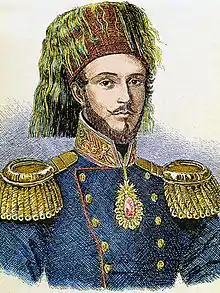
Another notable reform was that the turban was officially outlawed for the first time during Abdulmejid's reign, in favour of the fez. European fashions were also adopted by the Court. (The fez would be banned in 1925 by the same Republican National Assembly that abolished the sultanate and proclaimed the Turkish Republic in 1923).
Samuel Morse received his first ever patent for the telegraph in 1847, at the old Beylerbeyi Palace (the present Beylerbeyi Palace was built in 1861–1865 on the same location) in Istanbul, which was issued by Sultan Abdulmejid who personally tested the new invention.[17]
When Kossuth and others sought refuge in Turkey after the failure of the Hungarian uprising in 1849, the sultan was called on by Austria and Russia to surrender them, but he refused.[1] He also would not allow the conspirators against his own life to be put to death. The 1911 Encyclopædia Britannica says of him, "He bore the character of being a kind and honourable man, if somewhat weak and easily led. Against this, however, must be set down his excessive extravagance, especially towards the end of his life."[11]
In 1844 he created the Ottoman lira and in 1852 he instituted the Order of the Medjidie.
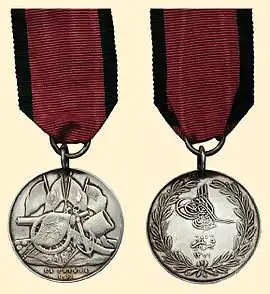
The Ottoman Empire received the first of its foreign loans on 25 August 1854 during the Crimean War. This major foreign loan was followed by those of 1855, 1858 and 1860, which culminated in default and led to the alienation of European sympathy from the Ottoman Empire and indirectly to the later dethronement and death of Abdulmejid's brother Abdülaziz.[11]
On the one hand, financial imperfections, and on the other hand, the discontent caused by the wide privileges given to the non-Muslim subjects again led the country to confusion. Incidents took place in Jeddah in 1857 and in Montenegro in 1858. The major European states have taken the opportunity to intervene in their own interests. The Ottoman statesmen, who panicked in the face of this situation, started following a policy that fulfilled their every wish. The fact that Abdulmecid could not prevent this situation further increased the dissatisfaction caused by the Edict of Tanzimat.[18]
The opponents decided to eliminate Abdulmejid and put Abdulaziz on the throne in order to prevent the European states from acting like a guardian. Upon a notice, this revolt attempt, which was referred to as the Kuleli Foundation in history, was suppressed before it even started on 14 September 1859. Meanwhile, the financial situation deteriorated and foreign debts, which were taken under heavy conditions to cover the costs of war, placed a burden on the treasury. All of the debts received from Beyoğlu consumers exceeded eighty million gold liras. Some of the debt securities and hostages were taken by foreign traders and bankers. The Grand Vizier who criticized this situation harshly, was dismissed by the sultan on 18 October 1859.[18]
His success in foreign relations was not as notable as his domestic accomplishments. His reign started off with the defeat of his forces by the Viceroy of Egypt and the subsequent signing of the Convention of London (1840), which saved his empire from a greater embarrassment. The Ottomans successfully participated in the Crimean War and were winning signatories at the Treaty of Paris (1856). His attempts at strengthening his base in the Balkans failed in Bosnia and Montenegro, and in 1861 he was forced to give up Lebanon by the Concert of Europe.[1]
Although he emphasized his commitment to the ceremonial rules imposed by his ancestors at the ceremonies reflected outside, he adopted radical changes in the life of the palace. For example, he completely abandoned the Topkapı Palace, which was a place for four centuries, about the Ottoman dynasty. The traditions of the British, French, Italian troops and officers and diplomats who came to Istanbul during the Crimean War (1853-1856) directed even middle-class families to consumerism and luxury. [19]
He restored the Hagia Sophia between 1847 and 1849, and was responsible for the construction of the Dolmabahçe Palace. He also founded the first French Theatre in Istanbul.[1]
He was made the 717th Knight of the Order of the Garter in 1856 and the 52nd Grand Cross of the Order of the Tower and Sword.
Many reconstruction activities were also carried out during the reign of Abdulmecid. Palaces and mansions were built with some of the borrowed money. Dolmabahçe Palace (1853), Beykoz Pavilion (1855), Küçüksu Pavilion (1857), Küçük Mecidiye Mosque (1849), Teșvikiye Mosque (1854) are among the main architectural works of the period. Again in this period, as was done by Bezmiâlem Sultan's Gureba Hospital (1845-1846), the new Galata Bridge was put into service on the same date. In addition, many fountains, mosques, lodges and similar social institutions were repaired or rebuilt.[18]
Death
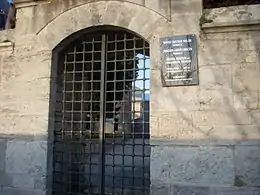
Abdulmejid died of tuberculosis (like his father) at the age of 38 on 25 June 1861 in Istanbul, and was buried in Yavuz Selim Mosque, and was succeeded by his younger half-brother Sultan Abdülaziz, son of Pertevniyal Sultan.
Issue
| Name | Birth | Death | Notes | References |
|---|---|---|---|---|
| By Servetseza Kadın | ||||
| None | ||||
| By Tirimüjgan Kadın | ||||
| Naime Sultan | 11 October 1840 | 1 May 1843 | • Born in Topkapı Palace. • Buried in Tomb of Mustafa III. | [20][21][22] |
| Abdul Hamid II | 21 September 1842 | 10 February 1918 | • Married thirteen times, and had issue, eight sons and nine daughters. | [23][21][24] |
| Şehzade Mehmed Abid | 22 April 1848 | 7 May 1848 | • Born in Çırağan Palace. • Buried in New Mosque. | [23][25] |
| By Düzdidil Kadın | ||||
| Mevhibe Sultan | 31 May 1840 | 9 February 1841 | • Born in Çırağan Palace. • Buried in Tomb of Abdul Hamid I. | [26][21] |
| Neyyire Sultan | 13 October 1841 | 18 December 1843 | • Born in Beşiktaş Palace. • Buried in Nuruosmaniye Mosque. | [27][21] |
| Münire Sultan | 13 October 1841 | 18 December 1843 | • Born in Beşiktaş Palace. • Buried in Nuruosmaniye Mosque. | [20] |
| Cemile Sultan | 17 August 1843 | 26 February 1915 | • Married once, and had issue, four sons and three daughters. | [28][21][29] |
| Samiye Sultan | 23 February 1845 | 18 April 1845 | • Born in Topkapı Palace. • Died in Çırağan Palace. • Buried in New Mosque. | [30][21] |
| By Şevkefza Kadın | ||||
| Murad V | 21 September 1840 | 29 August 1904 | • Married five times, and had issue one son and five daughters. | [31][21] |
| Aliye Sultan | 20 October 1842 | 10 July 1845 | • Born in Beşiktaş Palace. • Buried in New Mosque. | [32][21] |
| By Zeynifelek Hanım | ||||
| Behiye Sultan | 22 February 1841 | 3 June 1847 | • Born in Beşiktaş Palace. • Buried in New Mosque. | [27][21] |
| By Gülcemal Kadın | ||||
| Fatma Sultan | 1 November 1840 | 26 August 1884 | • Married twice, and had issue, one son and two daughters. | [33][21][34] |
| Refia Sultan | 7 February 1842 | 4 January 1880 | • Married once without issue. | [35][21][36] |
| Mehmed V | 2 November 1844 | 3 July 1918 | • Married five tines, and had issue, three sons and one daughter. | [37][21][36] |
| By Verdicenan Kadın | ||||
| Münire Sultan | 9 December 1844 | 29 June 1862 | • Married twice, and had issue, a son. | [30][21] |
| Şehzade Ahmed Kemaleddin | 3 December 1847 | 26 April 1905 | • Married once, and had issue, two daughters. | [25][38] |
| By Perestu Kadın | ||||
| None | ||||
| By Nükhetsezâ Hanım | ||||
| Şehzade Ahmed | 5 June 1846 | 6 June 1846 | • Born in Çırağan Palace. • Buried in New Mosque. | [39][21] |
| Nazime Sultan | 26 November 1847 | 1 December 1847 | • Born in Beylerbeyi Palace. • Buried in New Mosque. | [40][25] |
| Şehzade Mehmed Burhaneddin | 23 May 1849 | 4 November 1876 | • Married twice, and had issue, a son. | [26][25][41][29] |
| By Mahitab Kadın | ||||
| Sabiha Sultan | 15 April 1848 | 27 April 1849 | • Born in Çırağan Palace. • Buried in New Mosque. | [40][25] |
| Şehzade Ahmed Nureddin | 31 March 1852 | 3 January 1884 | • Married twice without issue. | [42][25][41] |
| Zekiye Sultan | 24 February 1855 | 18 February 1856 | • Buried in Tomb of Gülüstü Hanım. | [43][25] |
| Fehime Sultan | 24 February 1855 | 10 November 1856 | • Buried in Tomb of Gülüstü Hanım. | [44][25] |
| By Nesrin Hanım | ||||
| Şehzade Mehmed Ziyaeddin | 22 November 1846 | 27 April 1849 | • Buried in New Mosque. | [45][21] |
| Behice Sultan | 26 August 1848 | 21 December 1876 | • Married once without issue. | [46][29] |
| Şehzade Mehmed Bahaeddin | 24 June 1850 | 9 November 1852 | • Buried in New Mosque. | [47][25] |
| Şehzade Mehmed Nizameddin | 24 June 1850 | 9 November 1852 | • Buried in New Mosque. | [20][25] |
| By Nergizev Hanım | ||||
| Şehzade Mehmed Fuad | 7 July 1848 | 28 September 1848 | • Born in Çırağan Palace. • Buried in New Mosque. | [48][25] |
| By Bezmiara Kadın | ||||
| Mükbile Sultan | 22 February 1850 | 21 March 1850 | • Born in Çırağan Palace. • Buried in New Mosque. | [49][25] |
| By Nalandil Hanım | ||||
| Seniha Sultan | 21 December 1851 | 15 September 1931 | • Married once, and had issue, two sons. | [20][25][50] |
| Şehzade Mehmed Abdüssamed | 20 March 1853 | 5 May 1855 | • Buried in Yavuz Selim Mosque. | [51][25] |
| Şehime Sultan | 31 January 1855 | 22 May 1857 | • Buried in Tomb of Gülüstü Hanım. | [52][53] |
| By Ceylanyar Hanım | ||||
| Şehzade Mehmed Rüşdü | 31 March 1852 | 5 August 1852 | • Born in Çırağan Palace. • Buried in Tomb of Abdul Hamid I. | [51][25] |
| By Serfiraz Hanım | ||||
| Şehzade Osman Seyfeddin | 9 June 1852 | 2 July 1855 | • Born in Çırağan Palace. • Buried in Yavuz Selim Mosque. | [48][25] |
| Bedia Sultan | 1 October 1857 | 12 July 1858 | • Buried in Tomb of Gülüstü Hanım. | [54][53] |
| Şehzade Selim Süleyman | 25 July 1860 | 16 June 1909 | • Married five times, and had issue, two sons and one daughter. | [48][53][55] |
| By Şayeste Hanım | ||||
| Stillborn son | 3 February 1853 | 3 February 1853 | • Unknown place of burial. | [47][25] |
| Naile Sultan | 30 September 1856 | 18 January 1882 | • Married once without issue. | [54][53][22] |
| By Navekmisal Hanım | ||||
| None | ||||
| By Gülüstü Hanım | ||||
| Mediha Sultan | 31 July 1856 | 7 November 1928 | • Married twice, and had issue, a son. | [56][53][57] |
| Mehmed VI | 14 January 1861 | 16 May 1926 | • Married five times, and had issue, one son and three daughters. | [53][58] |
| By unknown consorts | ||||
| Şehzade Mehmed Vamik | 19 April 1850 | 6 August 1850 | • Buried in New Mosque. | [25] |
| Stillborn daughter | 16 December 1858 | 16 December 1858 | • Unknown place of burial. | [53] |
| Stillborn daughter | 30 May 1860 | 30 May 1860 | • Unknown place of burial. | [53] |
In fiction
- A fictionalized version of Abdulmejid I appears in the 2008 novel The Bellini Card, by Jason Goodwin.[59]
References
- "Abdulmecid I". Encyclopædia Britannica (online ed.). Encyclopædia Britannica Inc. Retrieved 27 December 2019.
- There are sources that state his birth date as 23 April.
- Garo Kürkman, (1991), Osmanlılarda Ölçü Ve Tartılar, p. 61
- Chambers Biographical Dictionary, ISBN 0-550-18022-2, page 3
- Since when is it called istanbul ?:Since 1453 and before the city is written استان, a-sitan or i-stan in Arabian sources and also later written as استانبول, a-stan-bol or i-stan-bul. Also the Commander of the City was called Commander of Istanbul (Ayrıca Osmanlı Ordusu’nda İstanbul'un merkez ordu komutanı için resmen İstanbul ağası ve İstanbul'un en yüksek sivil hakimi için resmen İstanbul efendisi sıfatları kullanılırdı)
- "Putnam's Monthly Magazine of American Literature, Science and Art Volume 0005 Issue 30 (June 1855)".
- "Gürcistan Dostluk Derneği".
- Bezmiâlem Valide Sultan, Bezmiâlem Vakıf Üniversitesi Tıp Fakültesi Hastanesi Archived 6 June 2012 at the Wayback Machine
- The Private World of Ottoman Women by Godfrey Goodwin, 2007, p.157
- Sakaoğlu 2015, p. 413.
-
 One or more of the preceding sentences incorporates text from a publication now in the public domain: Chisholm, Hugh, ed. (1911). "Abd-ul-Mejid". Encyclopædia Britannica. 1 (11th ed.). Cambridge University Press. pp. 36–37.
One or more of the preceding sentences incorporates text from a publication now in the public domain: Chisholm, Hugh, ed. (1911). "Abd-ul-Mejid". Encyclopædia Britannica. 1 (11th ed.). Cambridge University Press. pp. 36–37. - Kinealy, Christine (1997). "Potatoes, providence and philanthropy". In O'Sullivan, Patrick (ed.). The Meaning of the Famine. London: Leicester University Press. p. 151. ISBN 0-7185-1426-2.
According to a popular tradition, which dates back to 1853...
- Ó Gráda, Cormac (1999). Black '47 and Beyond. Princeton University Press. pp. 197–198. ISBN 0-691-01550-3.
...populist myths...
- Akay, Latifa (29 January 2012), "Ottoman aid to the Irish to hit the big screen", Zaman, archived from the original on 17 October 2013,
Legend has it ...
- Christine Kinealy (2013), Charity and the Great Hunger in Ireland: The Kindness of Strangers, p. 115
- "Inflation Calculator". Archived from the original on 12 March 2020. Retrieved 12 March 2020.
- Istanbul City Guide: Beylerbeyi Palace Archived 10 October 2007 at the Wayback Machine
- "ABDÜLMECİD عبد المجید (1823-1861) Osmanlı padișahı (1839-1861)". İslam Ansiklopedisi. Retrieved 12 April 2020.
- Sakaoğlu 2015, p. 422.
- Uluçay 2011, p. 218.
- Paşa 1960, p. 144.
- Brookes 2010, p. 285.
- Uluçay 2011, p. 205.
- Brookes 2010, p. 277.
- Paşa 1960, p. 145.
- Uluçay 2011, p. 217.
- Uluçay 2011, p. 220.
- Uluçay 2011, p. 221-224.
- Brookes 2010, p. 279.
- Uluçay 2011, p. 225.
- Uluçay 2011, p. 205-6.
- Uluçay 2011, p. 221.
- Uluçay 2011, p. 218-20.
- Brookes 2010, p. 281.
- Uluçay 2011, p. 220-221.
- Brookes 2010, p. 288.
- Uluçay 2011, p. 209.
- Brookes 2010, p. 283.
- Uluçay 2011, p. 216-17.
- Uluçay 2011, p. 226.
- Sakaoğlu, Necdet (2001). Avrupalılaşmanın yol haritası ve Sultan Abdülmecid. DenizBank. p. 238. ISBN 978-9-757-10450-6.
- Uluçay 2011, p. 210.
- Uluçay 2011, p. 228.
- Uluçay 2011, p. 229.
- Uluçay 2011, p. 215.
- Uluçay 2011, p. 2126-27.
- Uluçay 2011, p. 216.
- Uluçay 2011, p. 214.
- Uluçay 2011, p. 227.
- Brookes 2010, p. 289-90.
- Uluçay 2011, p. 212.
- Uluçay 2011, p. 227-28.
- Paşa 1960, p. 146.
- Uluçay 2011, p. 231.
- Brookes 2010, p. 290.
- Uluçay 2011, p. 220-31.
- Brookes 2010, p. 284.
- Brookes 2010, p. 291.
- "The Bellini Card". 18 January 2013.
Sources
- Brookes, Douglas Scott (2010). The Concubine, the Princess, and the Teacher: Voices from the Ottoman Harem. University of Texas Press. ISBN 978-0-292-78335-5.
- Uluçay, M. Çağatay (2011). Padişahların kadınları ve kızları. Ötüken. ISBN 978-9-754-37840-5.
- Sakaoğlu, Necdet (2015). Bu Mülkün Sultanları. Alfa Yayıncılık. ISBN 978-6-051-71080-8.
- Paşa, Ahmed Cevdet (1960). Tezâkir. [2]. 13 - 20, Volume 2. Türk Tarih Kurumu Basımevi.
External links
![]() Media related to Abdül Mecid I at Wikimedia Commons
Media related to Abdül Mecid I at Wikimedia Commons
![]() Works written by or about Abdülmecid I at Wikisource
Works written by or about Abdülmecid I at Wikisource
- . Collier's New Encyclopedia. 1921.
Abdulmejid I Born: 23 April 1823 Died: 25 June 1861 | ||
| Regnal titles | ||
|---|---|---|
| Preceded by Mahmud II |
Sultan of the Ottoman Empire 2 July 1839 – 25 June 1861 |
Succeeded by Abdulaziz |
| Sunni Islam titles | ||
| Preceded by Mahmud II |
Caliph of the Ottoman Caliphate 2 July 1839 – 25 June 1861 |
Succeeded by Abdulaziz |
.svg.png.webp)